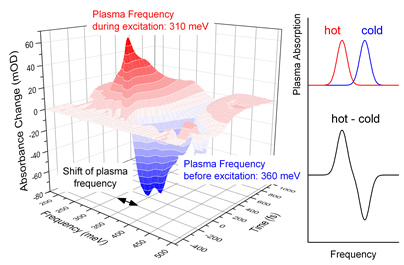Oscillations of an optically heated electron plasma depend sensitively on the plasma temperature. Ultrafast heating and cooling of a plasma in the semiconductor zinc oxide (ZnO) leads to pronounced shifts of plasma frequency, holding a strong potential for novel switching applications in optoelectronics.
A plasma is a special state of matter in which a large number of electrons form are negatively charged cloud of particles which is separated from a positively charged background of ions. Plasma exists in many systems including hot stars, the ionosphere and other ionized gases, as well as solid state materials. The electric forces between electrons and ions allow for generating periodic spatial motions of the electron cloud relative to the ions, so called plasma oscillations or plasmons. Recently, plasmons in metals and semiconductors have received strong interest. They display peculiar optical properties and hold strong potential for applications in high-speed optoelectronics and optical microscopy with sub-wavelength spatial resolution.
A basic and interesting question is: Can one manipulate plasma oscillations with light and, in particular, modify their frequency? This would allow for switching the electric and optical properties for a short period of time, changes most helpful for novel optoelectronic devices. In the current issue of Physical Review Letters [115, 147401 (2015)], a joint research team from the Max-Born-Institute and Humboldt University in Berlin demonstrates a novel concept for ultrafast plasmon switching in the semiconductor ZnO (Movie). In their experiments, the researchers investigated plasma oscillations in a 100 nanometer thick crystalline ZnO layer containing a high density of approximately 1020 free electrons per cubic centimeter. Plasma oscillations are excited by an infrared pulse of 150 fs duration (1 fs = 10-15 s) and the frequency shift of the infrared plasmon absorption band is measured with a second delayed and much weaker probe pulse. The shift of the absorption band allows for extracting the momentary plasma frequency as a function of time (Fig. 1). The experiments give direct evidence of a transient shift of plasma oscillations to lower frequency. The strong frequency reduction by 20% lasts for only 400 fs after which the original plasma frequency is restored. Over the period of the experiment, the electron density remains unchanged.
The physical origin of the frequency reduction lies in the transient heating of the electron plasma by the infrared excitation pulse. The electrons reach a peak temperature of ≈3300 K and populate a very wide range of the conduction band of ZnO (Fig. 2). In this range, the average electron mass is higher than in the initial state and, thus, the plasma frequency is reduced. The hot electrons transfer most of their thermal excess energy to the crystal lattice within some 400 fs. As a result, both the average electron mass and the plasma frequency return to their original values. All experimental observations are in excellent agreement with theoretical calculations.
Movie
Animation: Right: plasma oscillations in a thin ZnO layer. Negatively
charged electrons (blue clouds) oscillate collectively versus the
positively charged ions (red dots). Left: Such a plasma oscillation
resembles strongly a classical pendulum, i.e., a massive ball hanging on
a elastic spring. (i) For negative times t < 0 (time counter upper
left), the oscillation frequency is quite high due to the small mass of
the electrons. (ii) During the period 0 < t < 100 fs fs the pump
pulse heats the electron plasma (lighters below, temperature display
upper right) resulting in an elevated mass of the electrons in ZnO
(right) or increased mass in the pendulum (left). (iii) For t >100 fs
the probe pulse measures the plasma oscillation frequency again, now
showing a distinctly slower motion.
Fig. 1: Experimentally observed time-dependent shift of the plasma frequency in a thin ZnO layer. Left: 3D-plot of the absorption change as a function of the probe frequency and time delay between pump and probe pulses. Right: concept of a transient difference spectrum. The cold plasma (blue) shows an absorption peak at the plasma frequency of the cold electron gas. The pump pulse heats the plasma resulting in a red-shift of the plasmon resonance (red). In the time-resolved experiments we measured the so called difference spectrum, i.e., the absorption of the hot plasma minus that of the cold plasma (black).
Fig. 2: The conduction band of ZnO shows a non-parabolic band structure, i.e., the electron energy as a function of the electron momentum follows a hyperbola rather than a parabola. As a result electrons at the conduction band minimum are quite light (low energy, small mass) compared to the much heavier electrons (large mass) at high energies. A cold plasma (left) contains essentially light electrons whereas a hot plasma (right) contains many heavy electrons at high energies.
Original Publication: Physical Review Letters 115, 147401
Ultrafast Nonlinear Response of Bulk Plasmons in Highly Doped ZnO Layers
Tobias Tyborski, Sascha Kalusniak, Sergey Sadofev, Fritz Henneberger, Michael Woerner, and Thomas Elsaesser
Contact
| Dr. Micha Woerner Tel. 030 6392 1470 Prof. Dr. Thomas Elsaesser Tel. 030 6392 1400 |


